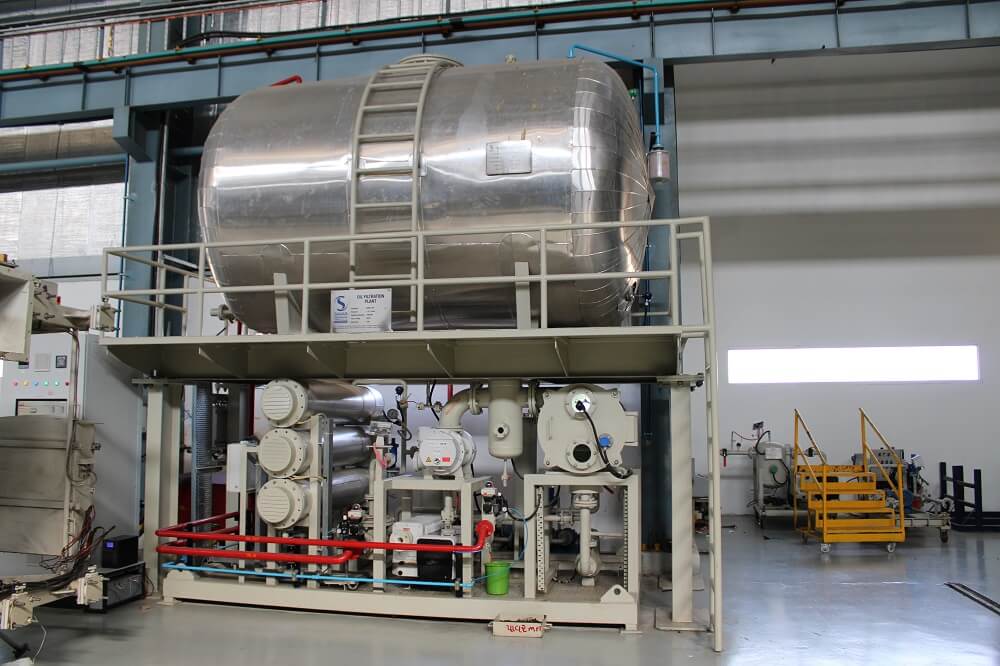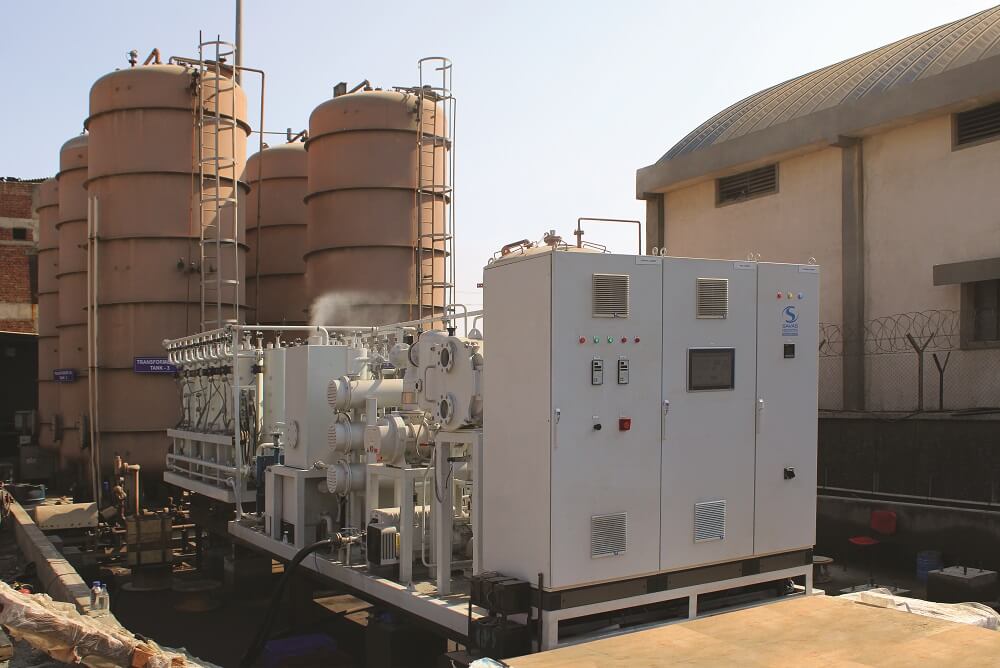What is Oil Filtration?
Oil filtration is using some basic method used to remove all suspended contamination from oil either for protection of the equipment (screening) or increasing the life of the oil (cleaning).
In simple words, Oil filtration is a method of extracting several contaminants either in a suspended state to protect the equipment, or to expand the service life of the oil.
Savas offers
• Single Pass
• Double Pass
• Stationary (with Canopy)
• Mobile (with Canopy)
• Capacity 250 LPH – 20000LPH
Table of Contents
Types of Oil Filtration
There are two different types of oil filtration:
- Primary purification
- Secondary purification
-
Primary purification
Primary purification is mainly used for protection of the equipment. The filtering devices are reinforced by the equipment producers.
From a technical point of view, the primary type of filtration is realized with a by-pass valve that allows flow of oil past and through the valve. This device helps to remove impurities of more than 25 microns.
This kind of filtration is also known as “coarse” filtration”. It is because of the size of contaminants being filtered. The major task of this kind of filtration is to avert equipment damage by coarse particles.
The filtering devices are mounted in the equipment’s lubrication circuit or in the delivery line that flows to the lubrication point.
Sometimes they are be mounted in the return pipeline that goes directly from the lubrication point mainly depending on the engineering concept and equipment manufacturer’s design.
Filters are generally made of porous materials. When filters become saturated with contaminants or when pressure goes beyond preset limits then they internal bypass valve opens
Non-filtered oil then flows out of the filter and is circulated into these equipment.
-
Secondary purification
A secondary filtration is applied in order to expand the service life of oil through by purifying and restoring the characteristics of oil’s performance.
Often, a secondary filtration method is known as “oil purification.” The major advantage of having this kind of filtration is that it increase the service life of the equipment as well as the oil.
Sometimes, several major producers provide equipment that has a built-in secondary filtration system, but often secondary filtration is regarded to be an optional piece of equipment.
The following are the most widespread methods of secondary filtration:
- Magnetic and vacuum cleanings;
- Dehydration;
- Centrifuge filtration; and
- Application of filtering materials.
Secondary filtration can clean the impurities of an oil to the lowest ISO purity class standard.
Even if secondary filtration systems are in place, it is not advised or recommended to change or remove the major filtration system mounted by the equipment manufacturer.
Some examples of oil cleaning or purification are vacuum dehydration, magnetic, depth filter media, centrifugal, or full flow filter media.
Primary filtration is essential and with very rare exceptions because there is no alteration of OEM filtration.
On the other hand, secondary filtration can add major benefit to the equipment owner by increasing the life of the oil in the system and the equipment.
Primary filtration will help safeguard the equipment investment whereas secondary filtration helps to stimulate the return on the equipment investment and also maximize the return on the oil investment.
 Oil Filtration: Cleaning Standards
Oil Filtration: Cleaning Standards
It should be clearly noted that the process of oil filtration needs to follow rules and major standards that guarantee the cleaning of the fluid because there are two standards regulated by international bodies. Examples are:
-
Standard ISO 4406:
This standard is widely used standard for measuring cleanliness of oil.
It is a representation guide, which focuses to simplify the particle count report, transforming the quantity found per milliliter of the sample and later on analyzing into a code that measures this value.
This standard generally works with 3 particle size references:
- 4 micrometers,
- 6 micrometers and
- 14 micrometers
-
Standard NAS 1638:
The NAS 1638 standard is considered more essential, practical and assesses the level of contamination by counting particles in 100 ml.
For this, it makes use of 5 major different size ranges which is
- From 5 to 15 micrometers,
- From 15 to 25 micrometers,
- From 25 to 50 micrometers,
- From 50 to 100 micrometers, or
- Greater than or equal to 100 micrometers.
Importance of oil Filtration
Cleaning oils is an important process for the proper functioning of equipment in several major industries and other productive activities.
The control and maintenance of contaminants in the machines is calculated to ensure the operational performance of this equipment, making it reach its beneficial life period predicted by its manufacturers.
In this context, the role of oil filtration becomes important because it is a systematic process capable of extracting as many impurities as possible.
If the levels of contamination by solids are continuously kept in safe limits and controlled then it is possible to reach levels of availability of machines, reliability, and availability of operating systems, in addition to guaranteeing their longer operational life.
Such improvements have a direct and major impact on the reduction of operating costs with right maintenance, since oil filtration is a resulting maintenance process.
The oil filtration also agrees and allows the reduction of operational losses in terms of productivity. In addition, oil filtration stop changes in component without being strictly necessary.
Benefits of Oil Filtration
There are several major benefits of oil filtration which helps to:
- Extend life of Hydraulic machine components
- Extend oil change interval
- Avoid unexpected failures
- Reduced loss of production
- Reduce machine break down time
- Reduce maintenance cost of machine
- Filters oil without affecting the properties of oil
- Reduced oil consumption
- It reduces the chances of stopped machines
- Prevents premature wear of parts
How Does Oil Filtration Occur?
Also known as filtration, oil filtration is a simple and effective process of passing through a permeable porous medium, a fluid in order to hold on to unwanted particles that are in suspension in it. It should be noted that the filtering capacity of a material depends on 3 major factors:
- Fluid pressure over the filter material area;
- Resistance of the filter material to the passage of the fluid;
- Resistance of the generated residue (filter cake).
There are two major types of filters: the first filer is called the surface filter, which is usually made of paper or fabric impregnated with hydrophobic resin (water repellent), whose permeability range is between 2 and 40 microns.
It is generally used in large surface areas, as the oil filtration has free flow and it is of low restriction.
The second type of filter is known as the depth filter, in which the solid particles are generally separated by deposition within the pores of the filter medium.
The second type of filter has a minimum thickness 100 times larger than the usual size of the particle to be filtered, being able to hold on to microscopic residues.
Manufacturers of Transformer Oil Filteration
We are leading manufacturers of transformer oil filtration plant which perform best when the insulating oil is dissolved gases, devoid of moisture, and unwanted particles.
Generally, this oil filtration plant is used for filtration, dehydration, and degassing of insulating oil. Transformer oil filtration plant is available in several varieties like Mobile Transformer Oil Plant, High Vacuum Transformer Oil Change Plant, Caster Wheel Mounted Transformer Oil Filtration Plant Trolley Mounted Filtration Plant and much more.
This plant make use of oil which keeps the transformer in good and clean condition which in turn increases its life.
Thus, it means that better the insulation of transformer, the life of transformer will be longer and there will be lesser breakdown of the transformer.
However, transformer oil filtration plant can be easily set up and availed by the customers at standard prices, according to their requirements.

